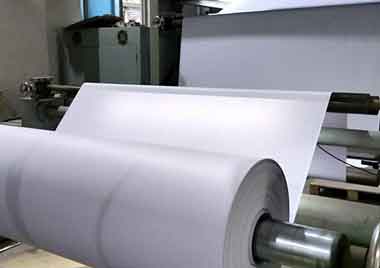Font Size:
Coating improves the printing properties of paper, so high-quality paper and board are coated. In paper coating, paint is applied to one or both sides of the paper. After applying the required amount of paint, the paint is dried and finished to improve the smoothness and gloss of the coated paper.
A. Composition of coating
1. Coatings are composed of several components. The most important of these ingredients are pigments. There can be only one pigment, or more commonly several pigments, in a paint. Depending on the circumstances, the pigment proportion in the dry paint is approximately 80% to 95% (mass fraction). Pigments are usually minerals from different origins, the most commonly used are kaolin (or china clay) and calcium carbonate.
2. Another important ingredient in the coating is the adhesive. The adhesive component of a coating usually consists of an adhesive mixture. The main purpose of the adhesive is to bond the pigment particles to the base paper and to bond them to each other. So it acts as a cement. The amount of the adhesive in the paint is about 5% to 20% (mass fraction) of the dry pigment. The lowest amount of adhesive is the rotogravure coating, and the highest is the offset printing coating. Adhesives can also affect the viscosity and flow of a coating.
3. In addition to pigments and adhesives, paints generally contain various additives that play different roles. The functions of these additives are to assist the dispersion of pigments, adjust pH, lubricate, optically brighten, and sterilize paints. The amount of additives is generally only below 2% (mass fraction) of the total solids.

B. Effects of coating on paper properties
1. Coating improves the smoothness and printability of paper. The coating fills in the voids and pores on the surface of the paper, which results in a smoother and more even surface. This leads to improved ink receptivity and reduced ink penetration, which enhances the sharpness and clarity of the printed image.
2. Coating also affects the opacity of the paper. The pigments used in the coating increase the opacity of the paper, which reduces show-through and enhances the whiteness of the paper.
3. The coating also improves the surface strength of the paper. The adhesive component of the coating helps to bond the paper fibers together, which provides increased resistance to tearing, folding and cracking.
4. Coating impacts the gloss level of the paper. The type and quantity of pigments used in the coating determine the level of gloss achieved. Gloss coatings can range from high gloss to matte finishes.
In conclusion, the application of a coating to paper can greatly enhance its properties and performance. The composition of the coating and the amount applied can have a significant impact on the resulting paper's appearance, printability, and strength.
C. How does coating affect the performance of paper?
We already know that coating fills the pits and covers the surface of the base paper, and coating greatly increases the smoothness of the paper. In addition, coated paper has the following effects:
(1) Decreased ink absorption.
(2) Increased surface strength and reduced dust spots.
(3) The gloss increases, and as a result, the printing gloss often increases while the non-printing area of the paper remains dull.
(5) Compared with coated and uncoated paper at the same quantitative time, the mechanical strength of the paper decreases. Increased opacity, and possibly whiteness.
(6) When the two papers are compared in the same quantity, the stiffness decreases.
Although we can obtain several useful properties by coating, we must remember that the properties of the base paper are very important to the properties of the final product.
The principle of carbonless paper
2021-02-06Paper chemicals - detailed analysis of defoamers
2021-02-06Surface Sizing Process Affecting Moisture Resistance of Packaging Paper
2021-02-06Introduction of thermal & pressure sensitive dyes-ODB-2
2021-02-06What are the types of coated paper?
2021-02-06The principle of carbonless paper
2021-02-06Paper chemicals - detailed analysis of defoamers
2021-02-06Surface Sizing Process Affecting Moisture Resistance of Packaging Paper
2021-02-06Introduction of thermal & pressure sensitive dyes-ODB-2
2021-02-06What are the types of coated paper?
2021-02-06